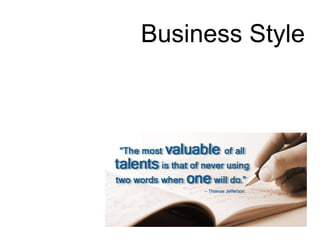
How to use tone in writing
- 3. How to use tone in your writing A writer's tone is very important: • it conveys a particular message from you as the writer . • it affects how the reader receives the message you are communicating. What Is Tone? Tone in writing can be defined as attitude or emotion toward the subject and the reader.
- 4. Using the appropriate tone in business writing is an important aspect of communicating the desired message and of achieving the desired results. When determining the appropriate tone to use, ask yourself: why you are writing the document: the purpose of the document. who the audience is. what you want readers to learn—to do with the information in the document. When you know the answers to these questions, you will be able to identify and use the appropriate tone. In turn, the appropriate tone will help you to engage your reader and propel him or her to action. Using the Appropriate Tone We commonly use a slightly different tone depending on the type of business correspondence we are writing.
- 5. Appropriate tone to use in particular kinds of business writing. • Awarding a promotion—appreciative, enthusiastic • Applying for a job position—enthusiastic, confident • Denying a request—regretful, courteous • Rejecting a job applicant—thankful, regretful • Declining a job offer—appreciative, regretful • Apologizing to a customer for a mistake—humble, appreciative to the person for being a client, confident that the mistake will be remedied • Apologizing to a customer; unable to correct the mistake—humble, appreciative, regretful that the mistake can not be remedied • Reprimanding an employee—firm but courteous (address the issue; don't attack the individual) Adapting Tone for Specific Types of Business Writing
- 6. 10 Tips for Using Tone in Business Writing 1 The tone for most business letters, memos, reports, instructional documentation, and so forth—should be fairly formal with some exceptions: e-mail messages you send to co-workers or others with whom you work closely when the message is sent in informal situations (for example, when inviting co-workers to lunch or reminding them of an upcoming meeting). Job position also plays a part in this; you might use a slightly different tone with your colleagues then you do with your boss, for example. If in doubt, let the communication style of others with whom you work be your guide. 2 Though most business correspondence is fairly formal, don't make the mistake of being too formal. There's no reason to say "In the event that" when "If" will do. 3 No matter the subject or the circumstances, you should be positive in your writing, even if the information is negative. Word choice is very important in accomplishing this.
- 7. “Because of recent declines in profits, no one will be getting a Christmas bonus this year”. “Unfortunately, due to the decrease in sales this year, we will not be awarding Christmas bonuses this year. However, we want to thank you, as always, for your outstanding performance as a top-notch employee, and we cordially invite you to our annual holiday party”. 10 Tips for Using Tone in Business Writing
- 8. 4 Your tone should be courteous and professional at all times, and it should convey strength and confidence. “This letter is to inform you that you will attend the upcoming mandatory meeting”. “We appreciate your attendance at the upcoming mandatory meeting”. “You did not assemble the parts correctly, and so the product is malfunctioning”. “The product may not work correctly if any errors occur during assembly”. When you use a confident and courteous tone, readers are more likely to agree and accept the message you are co If you are too tentative, readers might not take you seriously, but if you are too demanding, they might resent your r 10 Tips for Using Tone in Business Writing
- 9. 5 Be honest and sincere. Most readers can tell when someone is not being honest with them. You will be able to build greater trust with readers—be able to accomplish more—if they know they can believe what you say. 6 Always use appropriate language in business correspondence. • Refrain from using slang, bad grammar, or sloppy sentence constructions. • Use correct punctuation and capitalization. • Avoid discriminatory or derogatory language. 7 Avoid flowery language. • Don't be wordy to sound more eloquent or educated. • Use clear, concise, simple language without talking down to your readers. • In Business Writing "Clarity" and “Conciseness" are a MUST. 10 Tips for Using Tone in Business Writing
- 10. How to use tone in your writing 8 Use active rather than passive constructions in your writing. • The active voice is more direct, shorter and clearer. • It portrays confidence and a willingness to take responsibility for one's actions. 9 Take the time to write well. • A report to the members of your board is different from an e-mail to your old high school friend. • A report requires a great deal more thought and care. • When necessary, do research so that you are knowledgeable on the subject about which you are writing and can adequately express your ideas. • Write with clarity and confidence. 10 In some cases, you may need to give yourself some time before you write so that you can do so objectively. • Do not write correspondence when you're overly emotional. • Wait until the next day, if necessary.